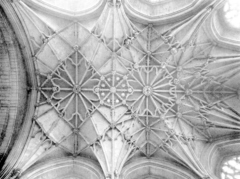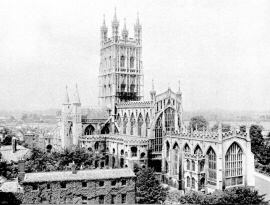The ‘Perpendicular' Period (1350-1400)
This style of Gothic architecture in England is referred to as
‘Perpendicular' because of its stark, rigid exteriorlines. There are elements
of an Egyptian influence due to the frequent visits many English
merchants, artists, and pilgrims were making to the east. New vaulting
techniques came into use that were more decorative in nature; some of
these were the net vault of Gloucester Cathedral pictured below. The Perpendicular
stage in Gothic became the standard for cathedral building for nearly
two hundred years, or until the Reformation.

The strong lines and metric feeling of the late fourteenth century is
due to the strong English monarchy of the time. Edward II was head of
a unified, wealthy and successful nation and these cathedrals
represented this in their proportions. His tomb is situated in the
ambulatory of Gloucester Cathedral, seen below, one of Britain's three largest
cathedrals. This magnificent tomb is a frequent site of pilgrimage.




Created by: Amy Johansen1999





